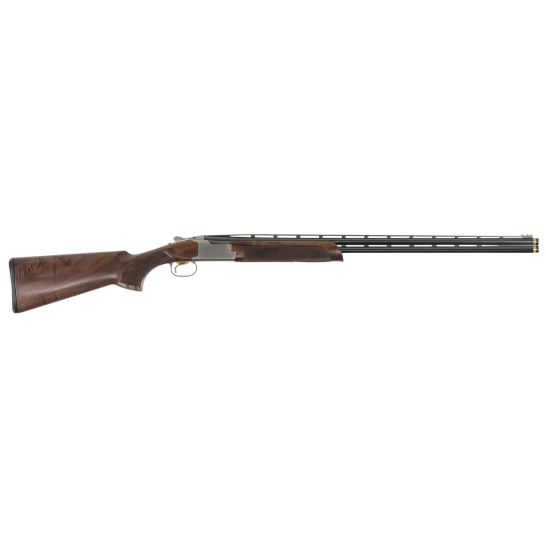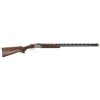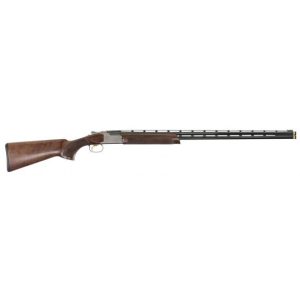Browning Citori 725 Sporting 28 Gauge Over/Under-Action Shotgun, Gloss Oil – 013531812 For Sale
$3,039.99
The Browning Citori 725 Sporting 28 Gauge Over/Under-Action Shotgun is a refined blend of tradition and innovation, building upon the legacy of John M. Browning’s B25 Superposed. This shotgun features a sleek Low-Profile receiver design that maintains the durability synonymous with the Citori line while offering improved balance and precision for an intuitive shooting experience. Key innovations include a robust full-width hinge pin and tapered locking bolt for durability, the FireLite Mechanical Trigger for a smoother pull, and Inflex Technology for reduced recoil. Crafted with a Grade III/IV walnut stock finished in lustrous gloss oil, the shotgun incorporates an adjustable comb, ergonomic handling, and gold-enhanced engraving for added elegance. Equipped with a HiViz Pro Comp sight, ivory mid-bead, and five extended choke tubes, it is ideal for sporting clays and skeet, employing the Standard Invector choke system in non-ported barrels. This model embodies superb craftsmanship and top-tier performance, catering to shooters who demand excellence.
What is the difference between Citori and Citori 725?
The primary differences between the Browning Citori and the Citori 725 involve design and performance features. The Citori 725 is essentially an evolution of the original Citori, offering several enhancements:
1. **Receiver Profile**: The Citori 725 features a lower profile receiver, which contributes to a more natural point and improved balance.
2. **Trigger System**: The Citori 725 includes the Fire Lite Mechanical Trigger, which is designed to offer a lighter, crisper trigger pull compared to the original Citori.
3. **Invector-DS Choke System**: The Citori 725 is equipped with the Invector-DS (Double Seal) Choke System, which provides improved patterns and a better gas seal for superior performance.
4. **Barrel Porting**: The Citori 725 often has barrel porting to reduce recoil and muzzle jump, though this can vary depending on the model and year of production.
5. **Recoil Pad**: Many Citori 725 models come with a better recoil pad system such as Browning’s Inflex II, which further reduces felt recoil.
Each of these changes aims to improve the performance, handling, and comfort of the shotgun, making the Citori 725 more suited for competitive shooting and other demanding applications compared to the original Citori models.
Is the Browning Citori 725 a good gun?
The Browning Citori 725 is generally considered a good shotgun, especially popular among shooting enthusiasts for its quality craftsmanship, reliability, and performance. Many users appreciate its low-profile receiver, which contributes to a more natural handling experience. It’s often praised for its smooth trigger pull, balance, and durability. However, whether it’s the right gun for you depends on your specific needs, preferences, and intended use, such as hunting or clay shooting. It’s always a good idea to handle one yourself or consult with experts to see if it suits your requirements.
Is the Browning Citori worth the money?
The Browning Citori is widely regarded as a high-quality shotgun known for its craftsmanship, durability, and performance. Whether it is worth the money depends on your specific needs and preferences. If you value excellent build quality, reliability, and are looking for a shotgun for activities like hunting or competitive shooting, the Browning Citori can be a worthwhile investment. However, if you are on a tight budget or do not require such features, there might be more affordable alternatives that meet your needs. Consider your budget, usage, and preferences when deciding if it is the right purchase for you.
What is a used Browning Citori worth?
The value of a used Browning Citori can vary widely depending on several factors including its condition, specific model, age, any included accessories, and the current demand in your area. On average, used Browning Citori shotguns can range from $1,000 to over $3,000. For a more precise valuation, it would be best to check recent sales on online auction or firearm sales platforms, visit local gun shops that sell used firearms, or consult with a firearms appraiser.
What does Browning Citori mean?
The Browning Citori is a line of over-and-under double-barreled shotguns produced by the Browning Arms Company. The Citori is known for its craftsmanship, reliability, and performance in various shooting activities, including hunting and clay shooting sports. It is one of Browning’s most popular shotgun models and comes in various gauges and configurations to suit different preferences and needs.
What is the difference between Browning 725 and 825?
The Browning 725 and 825 are both models of over-under shotguns, but they have some differences in features, design, and intended use.
1. **Design and Aesthetics**:
– The Browning 725 typically comes with a more traditional and elegant design, featuring high-quality walnut wood for the stock and forend.
– The 825 may have a more modern design with additional aesthetic features, potentially appealing to users looking for a visually distinctive firearm.
2. **Features and Performance**:
– The 725 is part of Browning’s Citori line and is known for its low-profile receiver, mechanical trigger, and innovative Invector-DS choke system for improved shot patterns.
– The 825 may incorporate additional technological advancements or features aiming to enhance performance, possibly including newer materials or ergonomic improvements.
3. **Intended Use**:
– The 725 is designed for a balance of hunting and clay shooting, offering versatility for different shooting disciplines.
– The specifics of the 825’s design may tailor it more toward specialized shooting sports or environments, though exact details would depend on the model’s features.
4. **Price and Market Positioning**:
– The 825 might be positioned at a different price point compared to the 725, reflecting its unique features or intended user base.
For the most accurate and current information, checking with Browning directly or visiting a retailer with detailed product comparisons would be recommended, as specifications can change over time or with special editions.
Does Browning Citori have ejectors?
Yes, the Browning Citori shotgun is equipped with ejectors.
Does Browning 725 have mechanical trigger?
Yes, the Browning 725 has a mechanical trigger system.
Is Browning made by Remington?
No, Browning is not made by Remington. Browning is a separate firearms manufacturer with its own brand and history. Although both companies produce firearms, they operate independently of each other.
What is the difference between Browning Citori grade 1 and grade 2?
The primary differences between the Browning Citori Grade 1 and Grade 2 shotguns typically lie in the level of finish and the quality of materials and craftsmanship used. Here are some common distinctions:
1. **Wood Quality**:
– **Grade 1**: Usually features a standard grade of walnut with a simpler finish, often more plain in appearance.
– **Grade 2**: Generally has higher-grade walnut, with more pronounced and attractive grain patterns, often with a gloss finish.
2. **Engraving and Aesthetic Details**:
– **Grade 1**: Typically has minimal or basic engraving, with a focus on functionality over aesthetics.
– **Grade 2**: Often includes more detailed engraving on the receiver and may have gold inlays or additional decorative features.
3. **Price and Collectibility**:
– **Grade 1**: More affordable, aimed at shooters looking for performance without extra ornamental features.
– **Grade 2**: Priced higher due to the added craftsmanship and aesthetics, appealing to those who appreciate the finer details in firearm design.
These differences cater to varying preferences for aesthetics and budget among gun enthusiasts. However, the core functionality and mechanical performance between the two grades remain similar. It’s always a good idea to inspect specific models for any additional differences or unique features.
When did the Citori 725 come out?
The Citori 725 was introduced by Browning in 2012.
What is the difference between 525 and 725?
The difference between 525 and 725 is 200.
What is the difference between 725 and 625?
The difference between 725 and 625 is 100.
| Product Line | Citori 725 Sporting |
|---|---|
| Action | Over/Under |
| Trigger Type | Mechanical (FireLite) |
| Sights | Hi-Viz Pro-Comp Front |
| Barrel Material | Steel |
| Receiver Material | Steel |
| Stock Material | Black Walnut |
| Barrel Finish | Polished Blue |
| Receiver Finish | Silver Nitride |
| Stock Finish | Gloss Oil |
| Chamber Length | 2-3/4" |
| Length of Pull | 14-3/4" |
| Overall Length | 48" |
| Checkering | Cut 20 LPI |
| Chamber Finish | Chrome Plated |
| Recoil Pad | Inflex 2, Large |
| Trigger Finish | Gold Plated |
| Trigger Guard Engraving | Buck Mark in Gold |
| Trigger Guard Finish | Silver Nitride |
| Trigger Guard Material | Steel |
| Trigger Material | Alloy |
| Choke System | Invector-DS Extended |
| Chokes | Full, Improved Modified, Modified, Improved Cylinder, Skeet |
| Drop at Comb | 1-9/16" |
| Drop at Heel | 2-3/16" |
| Rib Width | 5/16" to 7/16" |
| Wood Grade | Grade III/IV |
| Barrel Type | Vent Rib |
| Hand Orientation | Right |
Be the first to review “Browning Citori 725 Sporting 28 Gauge Over/Under-Action Shotgun, Gloss Oil – 013531812” Cancel reply
Related products
Browning Citori 725 Sporting 28 Gauge Over/Under-Action Shotgun
Browning Citori 725 Sporting 28 Gauge Over/Under-Action Shotgun, Gloss Oil – 013531811



Reviews
There are no reviews yet.